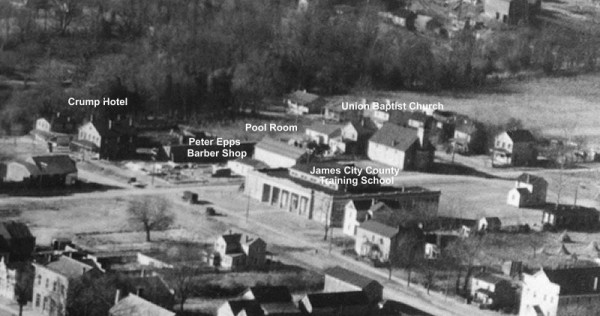
Detail of a 1928 Arial photograph showing Nicholson Street (diagonal) at Botetourt.
When we talk about history at Colonial Williamsburg, it’s the 18th century that comes first to mind. While the 18th century is certainly our research and interpretive focus, archaeologists spend a great deal of time (literally) sifting and sorting through evidence of other historic periods. It is simply the nature of our work. As we progress through successive accumulated soil layers, the excavation process reminds us that we are not uncovering history, but rather “histories”.
Between 1986 and about 1997, Colonial Williamsburg’s Brickyard was located on the northeast corner of Botetourt and Nicholson Streets.
This week we began thinking about a spring excavation. The site we have in mind is located at the northeast corner of Nicholson and Botetourt streets—lots owned in the 18th century by Joseph Davenport, the town clerk, and left to his son Matthew (William and Mary’s Writing Master) at his death in 1760. While we may know this as the Davenport Site, others have lived and worked here over the centuries. In recent memory, these lots served as Colonial Williamsburg’s brickyard before it moved to its present location closer to the Governor’s Palace.
The image at the top of this post records the same block, and the block adjacent to it, in 1928. In these years marking the beginning of Williamsburg’s restoration, this was the hub of Williamsburg’s African American community. The James City County Training School (1924-1940), serving African-American students, occupied the land that we are now considering for excavation. Across Botetourt Street a barber shop and a pool room were likely popular meeting places, especially “for males, where key topics on the public agenda were discussed, private information shared, and where customers relaxed and socialized.” [Edwards-Ingram: pg. 6, below] William Braxton owned a house on the block, and the “Crump Hotel”, run by Harriet Crump, provided accommodations for long-term boarders. The most enduring institution on the block, the Union Baptist Church, continued its activities into the mid-1960s, as the surrounding neighborhood was enveloped into Colonial Williamsburg’s Historic Area.
Sometimes, it is the nearest link to the past that is most accessible and engaging. To learn more about this 20th century neighborhood, and the people who lived there, we recommend the following articles:
- More than Memory: Representing an African American Neighborhood at the Ravenscroft Site by Colonial Williamsburg Staff Archaeologist, Ywone Edwards-Ingram the September 2011 issue of the African Diaspora Newsletter: http://www.diaspora.illinois.edu/news0911/news0911-2.pdf
- African Americans and the Restoration of Williamsburg by Mary Miley Theobald in the Summer 2014 edition of the Colonial Williamsburg Journal. http://www.history.org/Foundation/journal/Summer14/restoration.cfm
Thanks for the information! It is amazing when thinking of Williamsburg not just as the colonial town, but as a place where people worked and lived. That it was a thriving African American neighborhood is also especially interesting.